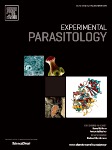Echinococcus granulosus. An intraperitoneal diffusion chamber model of secondary infection in mice.
Dublin Core
Título
Echinococcus granulosus. An intraperitoneal diffusion chamber model of secondary infection in mice.
Tema
ECHINOCOCCUS GRANULOSUS
BIBLIOGRAFIA NACIONAL QUIMICA
1998
Abstract
The present work describes a new experimental model of secondary infection which allows, through the recovery of the parasite together with its localin vivoenvironment, examination of the local nonadaptive immune response of the infected host and the differentiation of the parasite from protoscoleces to cysts. In this model we administered protoscoleces within silicone diffusion chambers, previously implanted into the peritoneal cavities of mice. The process of designing the model involved, first, determination of the optimal time postimplantation to infect the mice and, second, evaluation of the parasite's ability to establish infection within the chambers. The optimal time for infection was considered to be after the inflammation caused by implantation of the chambers had subsided. Our results showed that by day 20 postsurgery, three parameters used as indications of inflammation (complement C3, serum amyloid P protein, and polymorphonuclear cells in the peritoneum and in the chamber contents) had reverted to their normal levels. In our study of parasite differentiation, we found that 2–3% of the total number of parasites inoculated into the chambers were recovered as viable cysts after 100 days. Throughout the infection period, the population of parasites recovered was heterogeneous; certain parasite morphologies that have not been described previously were observed. In conclusion, the use of intraperitoneal diffusion chambers offers a potential tool for investigating thein vivodifferentiation process of secondary cysts ofEchinococcus granulosusin mice and the early local interactions between host and parasite during this process.
Autor
Breijo, M
Spinelli, P
Sim R.B
Ferreira, A. M
Fuente
Experimental Parasitology v. 90, 1998. -- p. 270-276
Editor
Elsevier
Fecha
1998
Derechos
Información sobre Derechos de Autor
(Por favor lea este aviso antes de abrir los documentos u objetos)
La legislación uruguaya protege el derecho de autor sobre toda creación literaria, científica o artística, tanto en lo que tiene que ver con sus derechos morales, como en lo referente a los derechos patrimoniales con sujeción a lo establecido por el derecho común y las siguientes leyes
(LEY 9.739 DE 17 DE DICIEMBRE DE 1937 SOBRE PROPIEDAD LITERARIA Y ARTISTICA CON LAS MODIFICACIONES INTRODUCIDAS POR LA LEY DE DERECHO DE AUTOR Y DERECHOS CONEXOS No. 17.616 DE 10 DE ENERO DE 2003, LEY 17.805 DE 26 DE AGOSTO DE 2004, LEY 18.046 DE 24 DE OCTUBRE DE 2006 LEY 18.046 DE 24 DE OCTUBRE DE 2006)
ADVERTENCIA - La consulta de este documento queda condicionada a la aceptación de las siguientes condiciones de uso: Este documento es únicamente para usos privados enmarcados en actividades de investigación y docencia. No se autoriza su reproducción con fines de lucro. Esta reserva de derechos afecta tanto los datos del documento como a sus contenidos. En la utilización o cita de partes debe indicarse el nombre de la persona autora.Formato
PDF
Idioma
Inglés
Tipo
Artículo
Identificador
doi:10.1006/expr.1998.4338
Document Item Type Metadata
Original Format
PDF
- Fecha de agregación
- August 5, 2015
- Colección
- Bibliografía Nacional Química
- Tipo de Elemento
- Document
- Etiquetas
- Echinoccocus granulosus
- Citación
- Breijo, M, “Echinococcus granulosus. An intraperitoneal diffusion chamber model of secondary infection in mice.,” RIQUIM - Repositorio Institucional de la Facultad de Química - UdelaR, accessed July 3, 2024, https://riquim.fq.edu.uy/items/show/3335.
- Archivos

